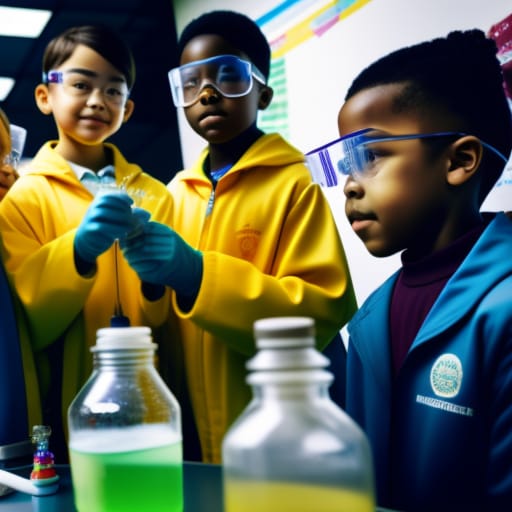Science kits can be an incredibly fun and educational way for 5th graders to explore science concepts through hands-on learning. With so many options out there, how do you choose the right science kit to spark curiosity and maximize your 5th grader’s learning experience? This comprehensive guide will walk you through everything you need to know, from the different types of science kits available to tips for selecting the best kits to match your child’s needs and interests.

What Are Science Kits for 5th Graders?
Science kits are hands-on tools designed to teach kids science concepts through experiments, projects, and other engaging activities. They come in all different themes like chemistry, physics, biology, engineering, and more. Many kits are specifically designed for the 5th grade level, covering topics kids learn in school curriculums.
The main types of science kits for 5th graders include:
- Chemistry kits – Develop lab skills through chemistry experiments like making slime or crystals. Learn about atoms, molecules, and chemical reactions.
- Physics kits – Explore concepts like motion, energy, light, and sound through hands-on projects.
- Robotics kits – Build and program robots and other mechanical devices. Develop engineering and coding skills.
- Nature/science kits – Observe plants, insects, and ecosystems up close. May include microscopes, butterfly gardens, and ant farms.
- General STEM kits – Engage in a variety of science, tech, engineering, art, and math activities.
Benefits of Science Kits for 5th Graders
There are many excellent reasons to introduce your 5th grader to science kits:
Promotes Hands-On Learning
Science kits allow kids to actively participate in science experiments instead of just reading about them. This type of experiential learning helps concepts stick.
Develops Critical Thinking
Following kit instructions, analyzing results, and drawing conclusions encourage critical thinking and problem-solving skills.
Sparks Interest in STEM
Fun science projects can inspire a passion for STEM fields that lasts into higher education and future careers.
Fosters Creativity & Imagination
Open-ended projects with room for innovation and discovery tap into kids’ natural creativity.
Reinforces Classroom Learning
Kits that align with the school curriculum provide an extra level of science reinforcement at home.
What to Look for in a 5th Grade Science Kit
There are a few key factors to consider when selecting a science kit for your 5th grader:
Age Appropriate
Make sure the kit is designed for ages 9-11, with projects and materials tailored to a 5th grader’s abilities. Avoid kits for much older or younger kids.
Learning Objectives
Look for kits that focus on STEM skills 5th graders are developing like the scientific method, measurement, data analysis, and critical thinking.
Parental Involvement
Some kits are designed for independent play while others encourage parent-child collaboration. Decide how hands-on you want to be.
Skill Level
Kits range from those requiring no experience to more advanced kits covering complex concepts only suitable for 5th graders on an accelerated science track.
Safety
For chemicals, electronics, and other tools, verify the kit includes adequate safety gear and easy-to-follow safety procedures.
Budget
Science kit prices run the gamut from $20 for extremely basic kits to over $100 for elaborate kits with lots of materials and projects. Set a reasonable budget.
Reviews
Check reviews on sites like Amazon to get a sense of real parents’ experiences with a kit before purchasing.
Top Science Kits for 5th Graders
Here are 5 of the best-reviewed and most recommended science kits to consider for 5th graders based on core science disciplines:
Chemistry
Thames & Kosmos Chem C3000 Chemistry Kit ($74.95 on Amazon)
This kit covers core chemistry concepts like acids, bases, pH indicators, reactions, and more through 50 cool experiments. Comes with all chemicals and gear needed. Ages 10+.
Physics
Scientific Explorer Magic Science for Wizards Only Kit ($24.99 on Amazon)
Young wizards will love these mesmerizing physics experiments teaching concepts like acids and bases, polymers, crystals, and more. For ages 5 and up.
Robotics
Makeblock mBot 1.1 STEM Educational Robot Kit ($79.99 on Amazon)
This programmable mBot robot kit lets kids build and then code their own robot! Learn about electronics, mechanics, and programming. Recommended for ages 8+.
Biology
Backyard Brains – SpikerBox EEG Kit ($199 from BackyardBrains.com)
Hook up electrodes to muscles, plants, or even your brain! See real neuroscience and biophysics in action. For ages 12+.
General STEM
Kiwi Crate STEM Projects ($19.95/month subscription on KiwiCo.com)
Each monthly science crate delivers a new hands-on STEM project on cool topics like engineering, ecology, space and more. For ages 9-16+.
Educational Science Experiments for 5th Graders
In addition to dedicated kits, there are tons of DIY experiments 5th graders can do using common household materials:
Kitchen Chemistry
- Bouncy Eggs – Make rubbery eggs by soaking in vinegar, then bouncing the contest!
- Lava Lamps – Suspend oil in water with Alka-Seltzer tablets.
Physics Fun
- Balloon-Powered Car – Use a balloon rocket to propel a straw and bottle cap car.
- Electromagnet – Make an electromagnet by wrapping wire around a nail and connecting it to a battery. Test its strength.
Backyard Biology
- Ant Farm – Observe an ant colony up close by housing ants in a transparent gel habitat.
- Microscope Slides – Make your own slides from pond water, plant materials, and cheek cells.
And so many more! Pick up a book like The Everything Kids’ Science Experiments Book for 100’s of super fun & educational hands-on science projects.

Tips for 5th Grade Science Fair Projects
Entering a science fair is a fantastic way for 5th graders to take a science kit project or homemade experiment to the next level. Here are some tips:
- Pick an interesting topic – Things like volcanoes, outer space, robots, and gross stuff are always big hits!
- Do thorough research – Learn everything you can about your topic before planning an experiment.
- Follow the scientific method – Your project should pose a clear hypothesis, follow rigorous steps, and draw conclusions from the data.
- Make a detailed display board – Show your findings with titles, photos, graphs, and diagrams. Get creative!
- Practice presenting – Be ready to explain your project, the science behind it, and the results to the judges.
With good planning and lots of curiosity, your 5th grader is sure to have a blast conducting their own science fair project!
Make Your Own Science Kits for 5th Graders
You don’t have to buy fancy pre-made kits to do science at home. Here are some easy ways to put together DIY science kits:
Kit in a Bag
Fill a ziplock bag with materials for a certain project, like a bag for making slime or crystals. Add all supplies plus instructions.
**Science Toolboxes **
Grab a toolbox and fill it with essential science equipment like goggles, beakers, funnel, pipettes, and rulers.
Themed Kits
Group materials together for certain science subjects – magnets, batteries, lights, and motors for physics or seeds, soil, and pots for botany.
Reuse Household Objects
Bottles, boxes, and plastic containers can be repurposed for sorts of experiments. Raid your recycling bin!
Following science websites, blogs, books, and videos gives you endless ideas for DIY science projects. Just provide any needed materials and let kids explore hands-on science!
Adapt Science Kits for Different Learning Needs
All kids deserve access to the excitement of hands-on science. Here are ways to adapt kits for different learners:
- Special needs – Provide extra assistance, modify instructions, and leverage strengths.
- Gifted students – Let them take the lead in designing projects, and allow independence.
- English language learners – Add visuals, demonstrations, and translations to instruction.
- Learning styles – Appeal to visual, auditory, and kinesthetic learners based on their needs.
- Environment – For virtual learners, provide lists of easy-to-acquire materials and add video demonstrations. Offer science kits for use in classrooms, after-school programs, or other group settings.
The key is making science engaging and educational for every child by adapting the experience to best fit each child’s unique requirements and environment.

Fun Science for Any Environment
Another great thing about science kits is that they lend themselves easily to any learning environment:
- In the classroom – Kits can supplement the curriculum and create excitement around STEM.
- At home – Open-ended kits with household materials allow for independent discovery and learning.
- After-school programs – Provide interactive science experiences in community and recreation centers.
- Camps & museums – Maximize hands-on fun and learning during summer programs and museum visits.
- Virtual learning – Select kits with common materials and add video instruction for distance learners.
Wherever curious young minds are found, science kits can pique their interest and feed their hunger for hands-on discovery!
Final Thoughts
The key to getting the most out of science kits is finding one that engages your individual child’s interests, appropriately challenges their abilities, and sparks the unique way they are wired to explore STEM concepts. Avoid kits that feel like boring assignments. Instead, let your 5th grader take the lead in their scientific journey, give them room to follow their curiosity, and watch their excitement for learning blossom!
For further reading, check out these resources:
Best Science Kits for Kids By Age – Reviews from Fatherly
Why Kids Need Hands-On STEM Activities – Benefits Overview from KiwiCo
35 Fun At-Home Science Experiments for Kids – Tons of DIY ideas from ParentMap
How will you harness the power of hands-on science kits to create an unforgettable learning experience for your 5th grader? With so many excellent options, you’re sure to find just the right one to launch your curiosity into orbit!
Frequently Asked Questions
What are the best science kits for 5th graders to learn chemistry?
For exploring core chemistry concepts like atoms, molecules, reactions, acids, and bases, an excellent choice is the Thames & Kosmos Chem C3000 Chemistry Kit. This kit allows kids to perform over 50 fun scientific reactions and experiments, teaching foundational chemistry skills. The detailed manual explains concepts while kids get hands-on experience. All materials and safety gear are included for ultimate educational value.
Should I help my 5th grader with their science fair project?
It’s fine to brainstorm ideas, provide materials, and offer advice, but try to let your 5th grader take the lead in designing and executing their science fair project themselves. While it can be tempting to help “ensure” a good result, over-involvement deprives kids of the chance to learn for themselves how to follow the scientific method, analyze data, identify variables, and draw original conclusions. Allow them independence to foster useful skills for future STEM studies and careers.
What are the best science experiments to do at home with 5th graders?
There are endless amazing DIY science experiments 5th graders can do using common household materials. My top picks are anything “slimy” like making oobleck (corn starch + water) or foam (glue + shaving cream). Building miniature rocket ships to launch or rubber band-powered cars are always hits. For biology, let kids grow seedlings or crystals. Simple physics experiments with magnets or static electricity never get boring. And chemical reactions like Diet Coke + Mentos eruptions fascinate kids while teaching science concepts.
Should I buy a kit or make my science kit for my 5th grader?
Pre-made kits take the guesswork out of gathering materials and offer step-by-step instructions for fun, educational science experiments. But homemade kits are equally fun for kids and let you tailor projects based on their unique interests. Start by talking with your child about what science topics excite them, then gather supplies to explore those hands-on. Mixing pre-made kits with DIY kits lets them experience science through both structured and self-directed learning.
How can I modify science kits to work for my 5th grader with special needs?
Making exciting science exploration inclusive for all students is easy with a few accommodations tailored to your child’s needs. Reduce unnecessary materials to limit overwhelm. Emphasize verbal explanations. Demonstrate steps before expecting independence. Offer encouragement and simplify complex procedures. Allow alternate outputs like oral explanations versus written ones. Most importantly, focus adaptations on highlighting their abilities, tapping into learning strengths and affinities. Proper modifications make science kits valuable for special needs students.